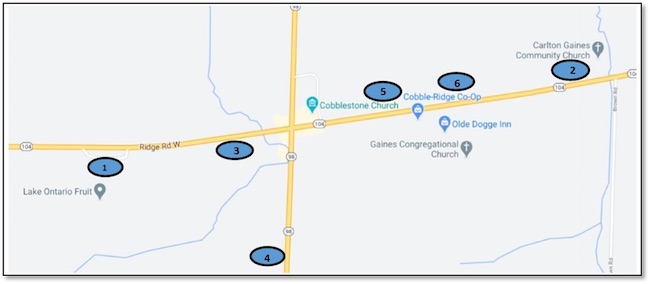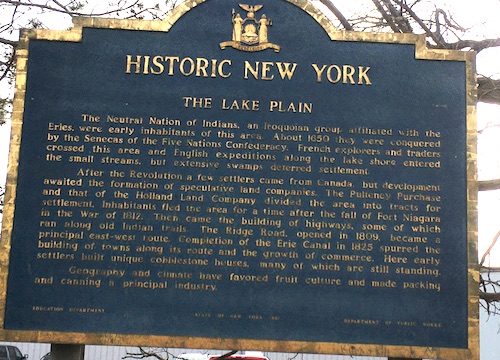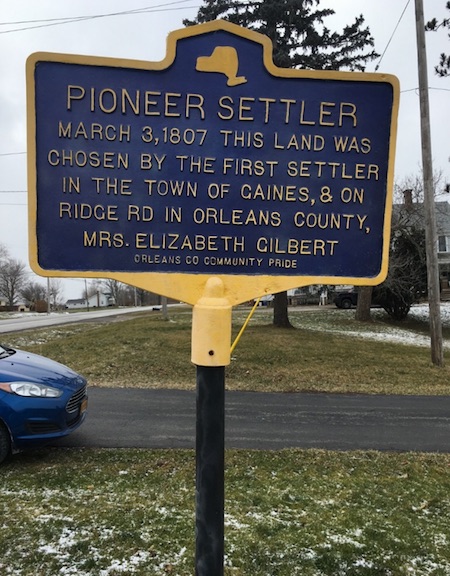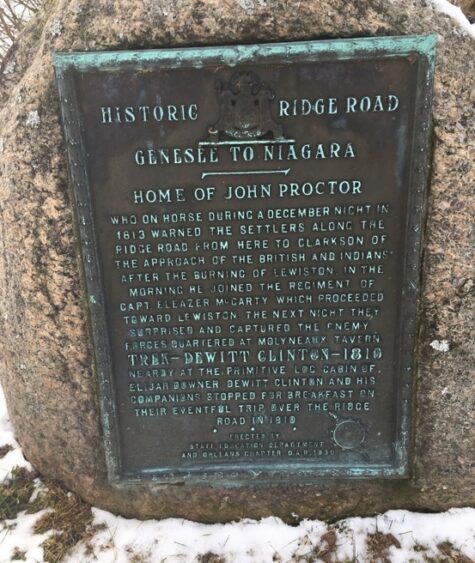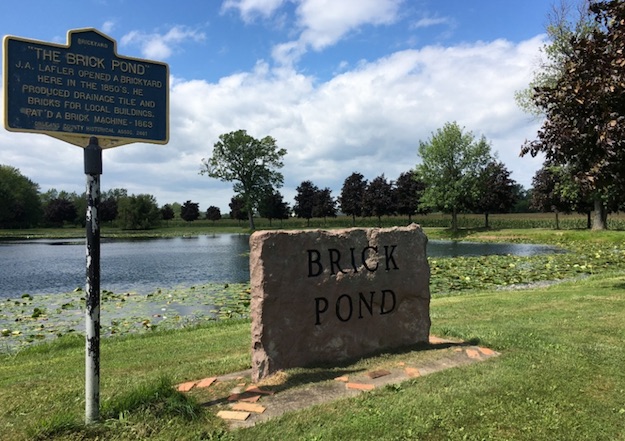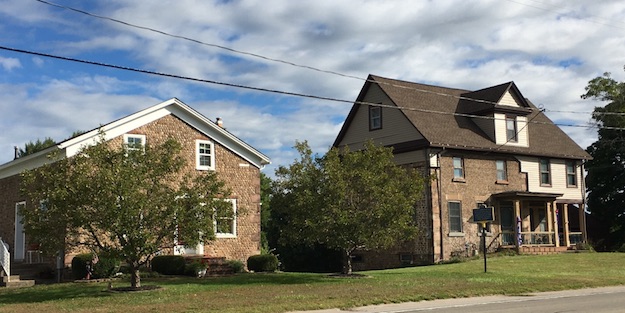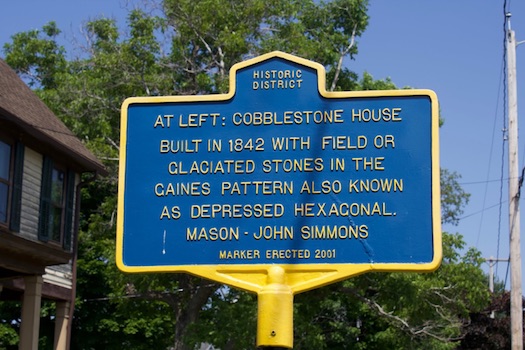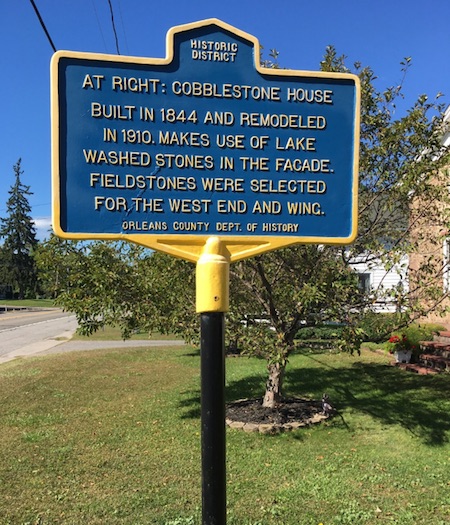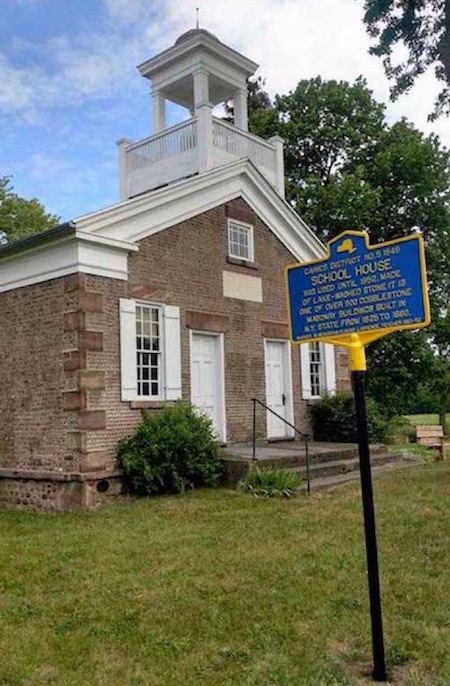Historic Childs: Markers highlight local history in Gaines hamlet
By Doug Farley, Cobblestone Museum Director
GAINES – Orleans County is fortunate to have over 100 historical markers and monuments that have been erected, largely in the 20th century, to highlight the region’s storied past.
Many are NYS Historic Markers, previously made of cast iron, but more recently aluminum, which are painted the traditional colors of blue and gold. The small Hamlet of Childs is also fortunate to host six of the historic markers.
Part of the problem with counting the number of markers in Childs is that the geographic boundaries of the hamlet are not well defined. No local government exists solely in the hamlet, but the old Town of Gaines School District #5 gives a good approximation of boundaries for Childs, centered on the intersection of Routes 104 and 98, and running about a half mile in each of the four directions.
(Map location 1) The largest historic marker in Childs is located in the parking area in front of the Lake Ontario Fruit plant on Route 104. It might qualify as one of the largest markers erected in New York State. The history of the historic marker, itself, is now an interesting story.
This marker didn’t come into existence without a little controversy along the way. Linda Schwartz was a youngster when her father, Robert Schwartz, transferred title to the New York State for the farm land used to create the parking area. Linda said, “The state took the land by eminent domain. They told my father to accept what he was offered or he would end up with nothing.”
Schwartz agreed when NYS promised to build a complete year-round rest stop with heated restrooms and picnic tables. A quick inspection of the parking area today would indicate the powers-to-be at NYS dropped the ball. John Russell, co-owner/manager of Lake Ontario Fruit, said he reluctantly took the bull by the horns several years ago and placed a rented portable restroom on the site to make it more user friendly and to make up for its lack of amenities. Russell said he’d love to get that item off his budget, but without another source of funding, he feels obligated to continue.
To history buffs, the state historic marker erected in the parking area is a bright spot in a less than satisfactory fulfillment of a state promise. Former Orleans County Historian Bill Lattin remembers that his father, Cary Lattin, was asked to create the text for the large historic marker in the parking area in 1961 during the latter’s tenure as County Historian. The actual text he used was:
HISTORIC NEW YORK – THE LAKE PLAINS
The Neutral Nation of Indians, an Iroquoian group affiliated with the Erie, were early inhabitants of this area. About 1650 they were conquered by the Senecas of the Five Nations Confederacy. French explorers and raiders crossed this area and English expeditions along the lake shore entered the small streams, but extensive swamps deterred settlement.
After the Revolution a few settlers came from Canada but development awaited the formation of speculative land companies. The Pulteney Purchase and that of the Holland Land Company divided the land area into tracts for settlement. Inhabitants fled the area for a time after the fall of Fort Niagara in the War of 1812. Then came the building of highways some of which ran along old Indian trails. The Ridge Road opened in 1809 became a principal east-west route. Completion of the Erie Canal in 1825 spurred the building of towns along its route and the growth of commerce. There early settlers built unique cobblestone houses, many of which are still standing.
Geography and climate have favored fruit culture and made packing and canning a principal industry.
Education Department – State of New York 1961. Department of Public Works
(Map location 2) The “Pioneer Settler” historic marker is located at Gaines Carlton Community Church at the end of Brown Street Road and Ridge Road. It celebrates Elizabeth Gilbert, described as the first settler in the Town of Gaines, who purchased 123 acres of land at this location in 1807, at a time that usually saw men owning property. Local history books retell the stories of “Widow Gilbert” who used her team of oxen to assist other settlers move their belongings onto their own recently purchased parcels of property. The full text of the sign reads:
PIONEER SETTLER
March 3, 1807 This land was chosen by the first settler in the Town of Gaines,
And on Ridge Road in Orleans County, Mrs. Elizabeth Gilbert.
ORLEANS COUNTY COMMUNITY PRIDE
(Map location 3) The founding father of the Hamlet of Childs (once known as Proctor’s Corners and Fairhaven), John Proctor is often referred to by historians as the Paul Revere of Ridge Road. On a cold December night in 1813, Proctor rode by horseback on the Ridge Road from Gaines to Clarkson to warn the settlers of the approach of British and the Indians after the burning of Lewiston during the War of 1812.
A historical marker on a large stone explains the story of John Proctor. The stone is on the south side of Ridge Road, a few houses west of the Route 98 intersection, in the lawn of a home currently occupied by Town of Gaines Historian, Adrienne Kirby, and her family.
The marker was put up in 1935 by the NYS Education Department and the Daughters of the American Revolution (DAR). It is one of a series of historical markers along Ridge Road that were erected in the 1920s and ’30s.
The Proctor marker also notes that the site was once occupied by a primitive log cabin owned by Elijah Downer. When Gov. DeWitt Clinton passed through in 1810, looking for a possible route for the Erie Canal, he stopped at the cabin for breakfast.
The full text of the monument reads:
HISTORIC RIDGE ROAD
GENESEE TO NIAGARA
HOME OF JOHN PROCTOR
Who on horse during a December night in 1813 warned the settlers along the Ridge Road from here to Clarkson of the approach of the British and Indians after the burning of Lewiston. In the morning he joined the regiment of Captain Eleazer McCarty which proceeded toward Lewiston. The next night they surprised and captured the enemy forces quartered at Molyneaux Tavern.
TREK – DEWITT CLINTON – 1810
Nearby at the primitive log cabin of Elijah Downer, Dewitt Clinton and his companions stopped for breakfast on their eventful trip over the Ridge Road in 1810.
Erected by the Ridge Road Improvement Association
Orleans Chapter DAR State of New York 1935
(Map location 4) The Hamlet of Childs is the site of historic Laffler Brick Yard built in the mid-1800s, and a state historic marker and a massive stone monument mark the spot on Route 98 a half mile south of Ridge Road. The Laffler Brick Yard had a storied history that included some game-changing technology for the time. Laffler built and patented an Iron Clad Brick Machine that changed brickmaking from a hand pressing process to mechanical. His invention was said to produce 2,000 to 3,000 bricks per hour. Enough bricks to build the average house could be made in a few hours instead of several days. Laffler’s machine took the first place award at the New York State Fair in the 1860s for several years running.
The full text of the historic marker reads:
BRICKYARD – THE BRICK POND
- A. Laffler opened a brickyard here in the 1850s. He produced drainage tile and brick for local buildings. Patented a brick machine – 1863.
Orleans County Historical Association 2001
(Map location 5) The Historic Hamlet of Childs is home to the National Historic Landmark Cobblestone District with three cobblestone structures that comprise a portion of the buildings owned by the Cobblestone Society & Museum. In addition, two other cobblestone buildings serve as private residences for their current owners and are the subject of a two-sided state historic marker located between the two houses on Ridge Road depicted here.
The sign facing west reads:
HISTORIC DISTRICT
At left: Cobblestone House built in 2842 with field or glaciated stones in the Gaines Pattern also known as Depressed Hexagonal. Mason – John Simmons
Marker Erected 2001
The sign facing east reads:
HISTORIC DISTRICT
At right: Cobblestone House built in 1844 and remodeled in 1910. Makes use of lake washed stones in the façade. Fieldstones were selected fro the west end and wing.
Orleans County Department of History
(Map location 6) The National Historic Landmark Cobblestone Schoolhouse (District #5) has its own state historic marker. The school, built in 1849, was constructed with a wooden frame and a facade of lake washed cobblestones. The one-room schoolhouse was used from 1849 to 1952 until the small local school districts were centralized and included in the Albion School District. The school serves as a time-capsule of early education in the county.
The sign reads:
GAINES DISTRICT No. 5 1849 – SCHOOL HOUSE
Was used until 1952. Make of lake-washed stone, it is one of over 900 cobblestone masonry buildings built in N.Y. State from 1825 to 1860.
Marker in Memoriam Elwood Lawrence, Teacher 1951-1952




























